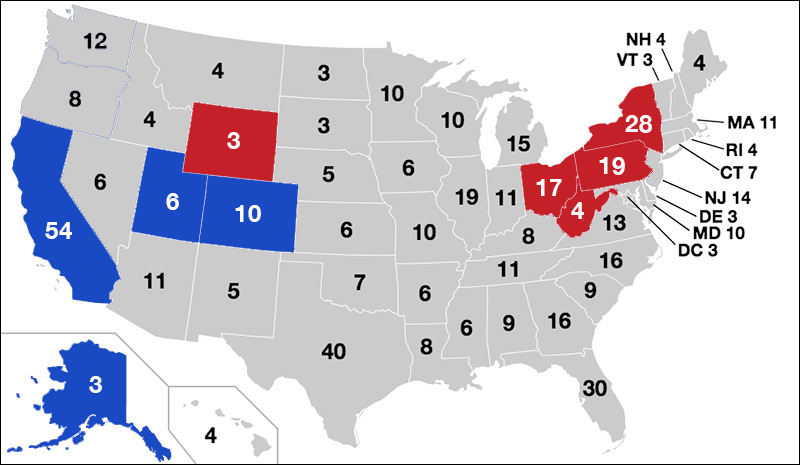By Jim Ellis — Thursday, Feb. 22, 2024
President
Decision Desk HQ: Projects Trump at 312 EVs — The Decision Desk HQ, in association with The Hill newspaper, has forecast a new 50-state electoral vote projection. All swing states are averaged based upon data from at least five recent polls. The new estimates give former President Donald Trump his largest-ever Electoral College vote lead, 312-226.The key swing states of Arizona, Georgia, Michigan, Nevada, North Carolina, Pennsylvania, and Wisconsin are all landing in the Trump camp according to DDHQ. To win the 2024 election, Trump needs to convert states that equal 35 electoral votes. According to this projection, Trump is improving his stance by 80 electoral votes when compared with his 2020 performance.
Senate
California: Primary Battle Over Second Place — Emerson College surveyed the California electorate in a partnership with The Hill newspaper and the Inside California Politics blog (Feb. 16-18; 1,000 registered California voters; 935 likely jungle primary voters; multiple sampling techniques) again found US Rep. Adam Schiff (D) leading the open US Senate field, this time with 28 percent of the vote. In second place, and for the first time with a sizable advantage over the third-place finisher, is former baseball great Steve Garvey (R) with 22 percent. Following are Reps. Katie Porter (D-Irvine) and Barbara Lee (D-Oakland) with 16 percent and nine percent, respectively.
The poll has a number of positive points for Garvey. Aside from the Emerson/Hill data suggesting he secures a general election slot, he does well with older voters. He registers a 33 percent preference total from those over 70 years of age, which is typically the highest turnout sector, and scores in second position with who voters believe would best handle the crime, homelessness, war in Israel, and immigration issues, while rating only three points below who would best handle abortion.
Additionally, the third-place finisher, Rep. Porter, does best with the youth vote, but this segment has the poorest participation history.
The California jungle primary is scheduled for Super Tuesday, March 5. The top two finishers regardless of political party affiliation or percentage attained will advance to the general election. Sen. Laphonza Butler (D), who Gov. Gavin Newsom (D) appointed to replace the late Sen. Dianne Feinstein (D), is not running for a full term.
Texas: Rep. Allred Establishes Strong Primary Lead, Cruz Likewise in General — YouGov, polling for the Texas Politics Project at the University of Texas at Austin (Feb. 2-12; 1,313 registered Texas voters; 1,200 likely Texas primary voters; online), tested the Lone Star State electorate for the coming March 5 primary election, and found US Rep. Colin Allred (D-Dallas), who has been using his resource advantage to advertise heavily, exceeding the 50 percent threshold within the Democratic primary segment. According to the YouGov results, Allred records a 52 percent preference figure as compared to state Sen. Roland Gutierrez’s (D-San Antonio) 14 percent.
Former Nueces County District Attorney Mark Gonzalez and state Rep. Carl Sherman (D-Dallas) register support figures of only five and two percent.
Within the general election sample, however, the tables turn. Here, Sen. Ted Cruz (R) records his best polling stance of the current campaign, with a 46-32 percent margin over Rep. Allred. The Daily Kos Elections site analysts criticized the poll because the questionnaire did not assign a party label with each candidate. They reason that Allred would have received better support had such been the case.
Two points of disagreement: first, the primary question was asked before the general election question, thus the voters were already told that Allred was a Democrat. Second, it is more likely that Sen. Cruz, who has not been overly popular in the state, would have actually benefited more with party labels since Texas has been a solid state for the GOP since the early 1990s.
House
NJ-8: Dueling Internal Dem Primary Polls — Last week, Rep. Rob Menendez (D-Jersey City) released the results of his internal TargetSmart survey that posted him to a relatively strong 46-22 percent advantage over Hoboken Mayor Ravi Bhalla in their quest for the Democratic nomination. On Wednesday, the Bhalla campaign countered with their own poll, this one from GQR Research another highly rated polling firm. This data (released Feb. 20; 403 likely NJ-8 Democratic primary voters) finds a much different ballot test, with the incumbent leading only 44-41 percent.
These polls, seemingly both well conducted, are far apart in how they view the race. This will be another of the most interesting primary contests to watch during our current election cycle.







